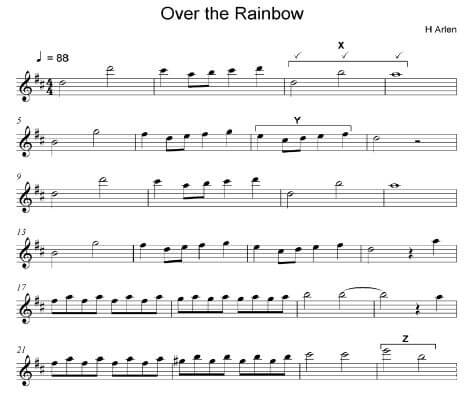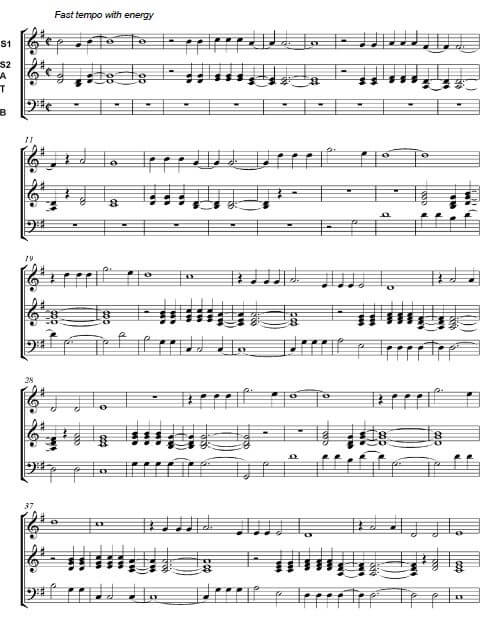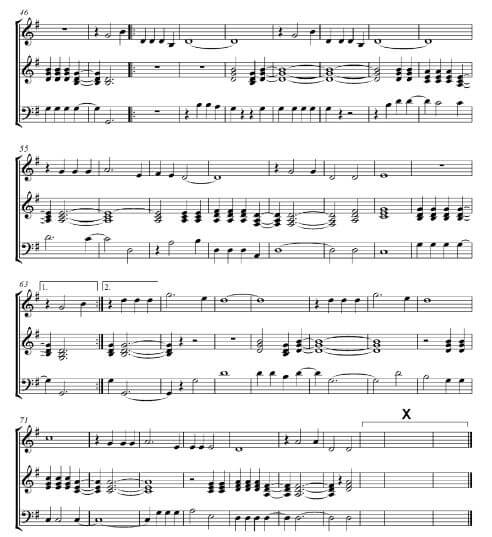MUSIC PAPER 2 GRADE 12 MEMORANDUM - AMENDED SENIOR CERTIFICATE EXAMS PAST PAPERS AND MEMOS MAY/JUNE 2018
Share via Whatsapp Join our WhatsApp Group Join our Telegram GroupMUSIC
PAPER 2
GRADE 12
AMENDED SENIOR CERTIFICATE EXAMS
PAST PAPERS AND MEMOS
MAY/JUNE 2018
MEMORANDUM
Note to the marker: Candidates must be credited for any correct answers not given in the memorandum. |
SECTION A: AURAL
QUESTION 1
Play Track 1 THREE times in succession. |
1.1 Which ONE of extract (a), (b) or (c) below best represents the solo voice part? Make a cross (X) in the appropriate block.
Answer: B (1)
Correct answer = 1 mark |
Play Track 2 TWICE in succession. |
1.2 Listen to the melodic and rhythmic phrase. Notate the rhythm of the missing notes in bars 2–3 below. 
Play Track 2 TWICE again. |
Answer:  (3) [4]
(3) [4]
½ mark per note as indicated = 3 marks |
QUESTION 2
Play Track 3 ONCE to provide a general overview. |
Listen to the extract below. Answer the questions that follow.
Answer score: 
Play Track 4 TWICE. |
2.1 Describe the role of the guitar in this extract.
Answer:
- Chordal accompaniment
- Harmonic support to melody
- Chordal homophonic texture supporting melody (1)
Any correct answer = 1 mark |
2.2 The notation of bars 3 and 4 has been omitted at X on the score. Fill in the missing pitches and note values that correspond with the music that you hear.
Answer:
See score (3)
Correct pitch and note value = 1 mark each |
Play Track 5 TWICE. |
2.3 Name the compositional technique used at Y. (The track starts in bar 5.)
Answer:
- Sequence
- Rhythmic repetition (1)
Any correct answer = 1 mark |
Play Track 6 TWICE. |
2.4 Name the interval formed between the given note and the missing note at Z. (The track starts with an upbeat to bar 21.)
Answer:
Perfect 4th (See score) (1) [6]
Correct answer = 1 mark |
TOTAL SECTION A: 10
SECTION B: RECOGNITION OF MUSIC CONCEPTS
QUESTION 3: GENERAL LISTENING (COMPULSORY)
Listen to the following tracks and answer the questions that follow.
Note to marker: if a candidate selected more than two items in a question, only the first two must be marked. |
Play Track 7 TWICE. |
3.1 With which items in COLUMN A do you associate the music that you hear in Track 7? Make a cross (X) in TWO appropriate blocks.
Answer: (2)
COLUMN A | Track 7 |
Marimba | |
Double bass melody | X |
Dorian mode (modal minor) | X |
Major key | |
Piano introduction | X |
Organ introduction |
First TWO correct answers = 2 marks |
Play Track 8 TWICE. |
3.2 With which items in COLUMN A do you associate the music that you hear in Track 8? Make a cross (X) in TWO appropriate blocks.
Answer: (2)
COLUMN A | Track 8 |
Brass section | X |
Ragtime | |
Swing | X |
Major key | |
Starts with djembe introduction | X |
Starts with floor tom-tom |
First TWO correct answers = 2 marks |
Play Track 9 and Track 10 TWICE each. |
3.3 Listen to two versions of Dona Nobis Pacem (Track 9 and Track 10) and answer the questions that follow.
3.3.1 With which items in COLUMN A do you associate the music that you hear in Track 9 and Track 10? Make a cross (X) in TWO appropriate blocks for EACH track.
Answer: (4)
COLUMN A | Track 9 | Track 10 |
Call and response | ||
SATB choir | X | |
Piano accompaniment | X | |
Starts with an introduction | X | |
Minor key | ||
Children's choir | X | |
Starts with a monophonic texture | X | |
A cappella | X |
First TWO correct answers per track = 2 x 2 = 4 marks |
3.3.2 With which TWO genres do you associate both versions of the work? Make a cross (X) in TWO appropriate blocks.
Answer: ![]() (2)
(2)
First TWO correct answers = 2 marks |
3.3.3 Indicate whether the statements below are TRUE or FALSE. Make a cross (X) in the appropriate blocks.
Answer: (2)
TRUE | FALSE | ||
(a) | Both performances begin with an upbeat. | X | |
(b) | Both performances end with a perfect cadence. | X | |
Correct answers = 2 marks |
(12 ÷ 3) [4]
Answer QUESTION 4 (WAM) OR QUESTION 5 (JAZZ) OR QUESTION 6 (IAM).
QUESTION 4: WAM
4.1 Listen to the extracts and answer the questions that follow.
Play Track 11 TWICE. |
4.1.1 From which movement of Beethoven's Symphony No. 6 is this extract taken?
Answer: First movement (1)
Correct answer = 1 mark |
Play Track 12 TWICE. |
4.1.2 With which items in COLUMN A do you associate the music that you hear in Track 12? Make a cross (X) in THREE appropriate blocks.
Answer: (3)
COLUMN A | Track 12 |
Triplet figure in accompaniment | X |
Development | X |
Adagio | |
Coda | |
Flute and oboe melodic material | X |
Clarinet and trumpet melodic material | |
Compound triple time | |
Repetition of motif in different keys | X |
First THREE correct answers = 3 marks |
4.1.3 Which prominent dynamic feature do you hear in this extract?
Answer:
- A gradual crescendo
- Crescendo poco a poco (1)
Any correct answer = 1 mark |
4.2 Listen to the extracts and answer the questions that follow.
Play Track 13 TWICE. |
4.2.1 Complete the table below by giving a description of EACH item in Track 13.
Answer: (4)
ITEM | DESCRIPTION |
Work | Hebrides Overture by Mendelssohn |
Style period | Romantic period |
Tempo | Allegro moderato |
Dynamics | p cresc. f decresc. |
Correct answers = 4 marks |
Play Track 14 TWICE. |
4.2.2 Which ONE of these Italian terms best describes the mood of the entire extract?
Answer: ![]() (1)
(1)
Correct answer = 1 mark |
4.3 Listen to the extracts and answer the questions that follow.
Play Track 15 ONCE. |
4.3.1 Name the TWO characters who sing this duet.
Answer:
- Pamina
- Papageno (2)
TWO correct answers = 2 marks |
Play Track 16 TWICE. |
4.3.2 Which type of articulation do you hear in the accompaniment part of this extract?
Answer:
- Detached chords
- Non-legato chords
- Staccato (1)
Any ONE correct answer = 1 mark |
Play Track 17 TWICE. |
4.3.3 Name the cadence that you hear at the end of this extract.
Answer: Imperfect cadence (1)
Correct answer = 1 mark |
4.3.4 Give a suitable Italian/German term that describes the mood or character of this music.
Answer:
- Tranquillo
- Cantabile
- Espressivo
- Ruhig (1)
Any correct answer = 1 mark |
Play Track 18 TWICE. |
4.3.5 Give the term for the vocal decoration in the soprano part on the single word, 'an'.
Answer: Melisma (1)
Correct answer = 1 mark |
(16 ÷ 2) [8]
TOTAL SECTION B: 12
OR
QUESTION 5: JAZZ
5.1 Listen to the extracts and answer the questions that follow.
Play Track 19 TWICE. |
5.1.1 With which items in COLUMN A do you associate the music that you hear in Track 19? Make a cross (X) in THREE appropriate blocks.
Answer: (3)
COLUMN A | Track 19 |
Bass and drum introduction | X |
Pentatonic scale | |
Piano and voice in unison | X |
Boogie-woogie | |
Syncopation | X |
Kwêla | |
Melodic ostinato | X |
Skiffle beat | |
Ghoema beat | X |
First THREE correct answers = 3 marks |
Play Track 20 ONCE. |
5.1.2 Which instrument(s) play(s) the melody?
Answer:
- Saxophone(s) (1)
Correct answer = 1 mark |
5.1.3 Name TWO features of this melody.
Answer:
- Stepwise/scale movement in the first section
- Improvisation in the second section
- Use of ornamentation (2)
Any TWO correct answers = 2 marks |
Play Track 21 TWICE. |
5.1.4 Give ONE or TWO word(s) to describe the style of the piano part.
Answer:
- Percussive playing
- Chordal romp
- Aggressive (1)
Any correct answer = 1 mark |
5.2 Listen to the extracts and answer the questions that follow.
Play Track 22 TWICE. |
5.2.1 Name TWO South African artists/bands with which you associate this extract.
Answer:
- Sipho Gumede
- Spirits Rejoice
- Sakhile (2)
Any TWO correct answers = 2 marks |
5.2.2 Briefly describe the role of the instruments below in this extract.
Answer: (3)
INSTRUMENT | DESCRIPTION |
Drum kit | Provides rhythmic drive Steady beat |
Bass guitar | Short improvised riffs Ostinato/Repetition |
Saxophone | Melodic improvisation Repeated melodic motif |
THREE correct answers = 3 marks |
5.3 Listen to the extract and answer the questions that follow.
Play Track 23 TWICE. |
5.3.1 Complete the table below by giving a description of EACH item in Track 23.
Answer: (3)
ITEM | DESCRIPTION |
Tonality | Major/Mostly I – IV – V - I |
Mood | Relaxed, laid-back, moderately lively |
Style | Kwela |
Correct answers = 3 marks |
5.3.2 This melody is played as a call and response. Name the instrument playing the call.
Answer:
- Saxophone (1)
Correct answer = 1 mark |
(16 ÷ 2) [8]
TOTAL SECTION B: 12
OR
QUESTION 6: IAM
6.1 Listen to the extract and answer the questions that follow.
Play Track 24 ONCE. |
6.1.1 Identify the style of music in this extract.
Answer: Maskandi (1)
Correct answer = 1 mark |
6.1.2 Give TWO reasons for your answer to QUESTION 6.1.1.
Answer:
- Introductory isihlabo
- Isihlabo played by concertina
- Guitar played in a picked style (ukupika)
- Call and response between the leader and the backing singers
- Izibongo (praise poetry) (2)
Any TWO correct answers = 2 marks |
6.1.3 Name TWO artists which you associate with this extract.
Answer:
- Phuzekhemisi
- Shwi Nomtekhala
- Hash 'elimhlophe (2)
Any TWO correct answers = 2 marks |
6.2 Listen to the extracts and answer the question that follows.
Play Track 25 and Track 26 in succession. |
With which items in COLUMN A do you associate the music that you hear in Track 25 and Track 26? Make a cross (X) in TWO appropriate blocks for EACH track.
Answer: (4)
COLUMN A | Track 25 | Track 26 |
Aerophones | X | X |
Monophonic texture | ||
Syncopation | X | X |
Guitar introduction | ||
Descending melodic motive | X | X |
Ukuvamba | ||
Dipoko (Praise poetry) | X |
First TWO correct answers per track = 2 x 2 = 4 marks |
6.3 Listen to the extracts and follow the instructions that follow.
Play Track 27 ONCE. |
6.3.1 Describe TWO features of the rhythmic material used in this extract.
Answer:
- Repetition of rhythmic patterns
- Moderately fast rhythmic material used
- Extensive use of syncopation
- Use of typical drum rudiments (flam, drag, etc.)
- Compound time signature (2)
Any TWO correct answers = 2 marks |
Play Track 28 ONCE. |
6.3.2 Identify the vocal technique that you hear in this extract.
Answer: Crepitation/Shouting/Pitch bending (1)
Any correct answer = 1 mark |
6.3.3 Explain the purpose of the vocal technique used in this extract.
Answer:
- To increase excitement
- To show enjoyment of the performance (1)
Any correct answer =1 mark |
6.4 Listen to the extracts and follow the instructions that follow.
Play Track 29 ONCE. |
6.4.1 Identify the style of music in this extract.
Answer:
- Isicathamiya (1)
Correct answer = 1 mark |
6.4.2 Give TWO reasons for your answer to QUESTION 6.4.1.
Answer:
- Male choir/ensemble (TTBB)
- Repetitive cyclic harmonic progressions
- Call and response/overlapping voices (2)
- Use of crepitation
Any TWO correct answers = 2 marks |
(16 ÷ 2) [8]
TOTAL SECTION B: 12
SECTION C: FORM
QUESTION 7
Read and study the questions for ONE minute.
Play Track 30 ONCE to provide a general overview. |
Listen to the piece below while you study the score. 

Play Track 30 again. |
7.1 What is the overall form of this piece?
Answer:
- Ternary form
- ABA
- Intro AABBA (1)
Any correct answer = 1 mark |
7.2 Motivate your answer to QUESTION 7.1 by giving a schematic layout of the form. Use the table below.
Answer: (3)
SECTION | BAR NUMBERS | MARKS |
A - ½ (including Introduction) | 1–47 ½ | = 1 mark |
B - ½ | 48–63 ½ | = 1 mark |
A ½ | 64–80 ½ | = 1 mark |
OR
SECTION | BAR NUMBERS | MARKS |
Introduction | 1–151 | |
AA - ½ | 152–47 ½ | = 1 mark |
BB ½ | 472–64 ½ | = 1 mark |
A ½ | 64–80 ½ | = 1 mark |
½ mark for each correct section (3 sections) = 1½ marks ½ mark for each correct set of bar numbers (3 sets of bar numbers) = 1½ marks |
7.3 Name the key of this piece.
Answer: G major (1)
Correct answer = 1 mark |
Play Track 31 TWICE. |
7.4 Does the work start with a homophonic or polyphonic texture?
Answer: Homophonic (1)
Correct answer = 1 mark |
Play Track 32 ONCE. |
7.5 Choose the term which best describes the vocal technique in this piece. Make a cross (X) in the appropriate block.
Answer: ![]() (1)
(1)
Correct answer = 1 mark |
Play Track 33 TWICE. |
7.6 Name the cadence at the end of the piece in bars 78–80 at X. (The track starts with the upbeat to bar 78.)
Answer:
- Plagal cadence (1)
Correct answer = 1 mark |
Play Track 34 ONCE for a final overview. |
TOTAL SECTION C: 8
GRAND TOTAL: 30